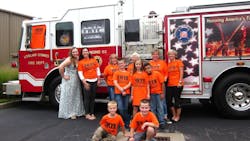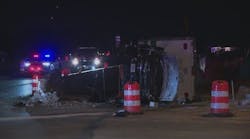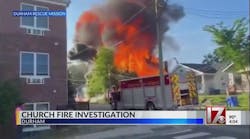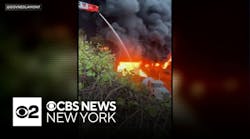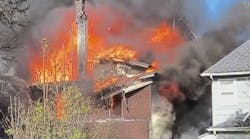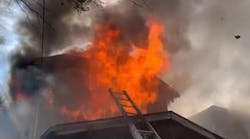Last month, I introduced a different kind of Close Call—the story of one of our very own District Chiefs Jon Frye, who was diagnosed with leukemia. Jon bravely shared with Firehouse his story of diagnosis and treatment, and also offered advice about how firefighters can reduce their exposure to potentially harmful chemicals.
This month, we’ll hear from the Loveland-Symmes Fire Department (LSFD) Chief Otto Huber, offering his perspective on what a chief can do in these situations, as well as from Jon’s wife, Teresa, on the impact a cancer diagnosis has on loved one. Then I’ll offer my own perspective and recommendations on how we can stay safe on the job.
LSFD Chief Otto Huber’s perspective
The last thing any fire chief wants to hear is that one of their firefighters is missing, injured or, in this case, horribly sick. When I found out that District Chief Frye was ill and that the prognosis was not good, my thoughts were that the job, our job, may have contributed to his illness. The first things that ran through my mind were:
- What can we do to help Jon and his family?
- Could we have prevented this?
- Did our equipment or policy—or the lack thereof—contribute to what Jon had to now fight?
- What could I have done as the chief to prevent this?
- Do I need to take immediate action to keep others from being afflicted?
As I did my best to process what Jon was now facing, the thought that came to the forefront was that there will be time for my above questions to be faced—later. However, right now, we need to focus on the task-level work and get Jon well … and who better to manage that task-level work then his brothers and sisters? Our members (and firefighters and friends from many other area departments and communities) circled the wagons and never gave up on Jon. Our firefighters’ entire focus turned to ensuring that Jon and his family’s every need was met. As the chief, it was on me, and my job was to ensure and promise Jon that all he needed to do was to focus on fighting and getting better. We took care of everything else and made it clear to him that his brothers and sisters have his back for every minute of this battle. I am proud of the men and women of LSFD and how they came together to support our brother; they are a remarkable group whose words are backed up by actions that never quit.
What about the others items I mentioned above? While I didn't address them immediately because of my focus on Jon, we have since taken aggressive additional steps related to firefighter cancer awareness, fireground operations, decon/cleaning issues and future organizational planning. My staff chiefs, company officers and I have taken a very strict no-nonsense, zero tolerance stance toward any measurable smoke exposure (use of masks, PPE, etc.) to the point that I know none of our personnel would even think of operating contrary, as cancer hit home for us all. Jon isn't the only member of our department family to fight the cancer battle. We have (and have had) others, but Jon's age (41) along with so many other firefighters being diagnosed, and the numerous firefighter cancer studies, all served as a wake up call or “punch in the gut” to each of us. We will absolutely not screw around when it comes to exposure that we can minimize at any scene where we are operating. I urge my peers to please do the same.
Teresa Frye’s perspective:
I remember a few weeks before Jon was diagnosed with leukemia, being concerned about his fatigue. It seemed to come on very quickly but when he called me from work one afternoon to tell me that he couldn’t get out of bed, I was gravely alarmed.
Jon came home from work that afternoon and called in sick the next day to see his primary care doctor. She seemed as puzzled with his symptoms and complaints. I recall feeling that he was probably dealing with a viral infection, which was obviously alarming, but never did I dream we would hear in just a few short days that he had cancer.
Jon suffered from a terrible headache for two days while waiting for answers. I walked into the hospital room early that morning to bring pillows from our bed. I was terrified with his pain level and how morphine was not touching the pain.
I remember walking out of the hospital to try to go to work and crying, feeling helpless. I called the nurse when I was driving to work asking many questions, trying to push for answers or at least to do something for him. Jon was writhing in pain and this obviously changed any initial thoughts I had of this just being some crazy virus.
The next 24 hours were agony waiting for the results of the bone marrow biopsy. But that call from the oncologist was life-changing. I was aware of leukemia being cancer, but honestly, I wasn’t prepared for the information we received within minutes of walking into Jewish Hospital.
Jon still had a horrific headache that we later learned was a symptom of leukemia. Jon was sent to Jewish Hospital, which is located just 12 houses from our home. We were hopeful this meant something positive on our short drive from Bethesda North to Jewish Hospital Bone Marrow Unit. Within minutes of arriving, we learned that he had blood cancer, he would receive a central line that day for chemo to start tomorrow and finally that he would be there for 30 days.
I was speechless. I was without words, and all I wanted to do was cry and scream. How is this happening? Jon and I were in shock taking in the initial information of how our lives and how Jon’s life were very different from just a few hours ago. That afternoon we met his new oncologist, Dr. Islas, and asked a few questions related to having planned a cruise at Christmas and about our wedding, which we had just started to plan for March 2015 in Disney World. Dr. Islas responded immediately, “No to the cruise, maybe to your wedding.”
That day and the days and weeks to come were surreal. I could never have fully understood the brotherhood of those in the fire service profession. The first day of Jon’s diagnosis brought more than a dozen coworkers to the hospital with a plan for meals, support for cutting the grass, carpools and more. His chief had “gathered the troops.” The physical and emotional support was undeniable and without a doubt the difference between just surviving but actually making it through each day with a smile.
While Jon is dealing with leukemia each and every day, I have learned how to modify our lives to minimize the risk for Jon to develop an infection. I was surprised to also learn about the increased risks for development of a variety of cancers from being a firefighter. I have always admired Jon and other firefighter for their sacrifice for strangers in need, but I was alarmed by the high risk for exposure again to Jon. He was always eager to get back to work and has since returned to work full time, but I must admit that I worry each and every day when he walks out the door.
Chief Goldfeder’s perspective
Perhaps it’s because I am older that I hear more about firefighter cancer. Maybe it’s because of the Internet where information is so readily available. Or maybe it’s because of groups such as the Firefighter Cancer Support Network that we are so much more aware. Or maybe it's because so many firefighters are dying annually from cancer. Odds are you know (or knew) a firefighter with cancer. I can name over a dozen friends of mine who are no longer with us.
We are just beginning to understand the horrific magnitude of the problem, the challenges involved, and the changes required in education, training, operations, medical screenings and personal accountability to effectively address cancer in the fire service. But not everyone is “getting it.”
While we are getting better and getting the message out there, every level of leadership and membership must own this. I was recently assigned as the safety chief at a nearby garage fire. It was a very large detached garage loaded with automotive “let’s cause cancer when burning”-type stuff. One of my first size-up observations was a crew operating in the smoke-packed garage—without SCBA—and I immediately took care of the problem. I wasn't particularly nice and my orders were very clear. No worries about who likes who. No worries about being seen as nasty or mean. No worries about gossip. I had no worries except one—trying to prevent those careless firefighters from having to go through what Chief Frye went through. They now understand very clearly. It's 2015. Look around. I'll bet you know a firefighter with cancer. Enough unnecessary exposure.
11 immediate actions
The Firefighter Cancer Support Network assembled representatives from IAFF, NFFF, IAFC and other fire service, medical and legal participants for a 2013 white paper called “Taking Action Against Cancer In The Fire Service.”
The white paper, among other great information, lists 11 immediate actions that you can take today to protect yourself against carcinogen exposure. Use these 11 immediate actions to size-up yourself and the firefighters operating with you so you can lessen the chances for cancer:
- Use SCBA from initial attack to finish of overhaul. (Not wearing SCBA in both active and post-fire environments is the most dangerous voluntary activity in the fire service today.)
- Do field decon of PPE to remove as much soot and particulates as possible.
- Use moist wipes to remove as much soot as possible from head, neck, jaw, throat, underarms, and hands immediately, while still on the scene.
- Change your clothes and wash them immediately after a fire.
- Shower thoroughly after a fire.
- Clean your PPE, gloves, hood, and helmet immediately after a fire.
- Do not take contaminated clothes or PPE home or store them in your vehicle.
- Decon fire apparatus interiors after fires.
- Keep bunker gear out of living and sleeping quarters.
- Don’t use tobacco products.
- Use sunscreen or sunblock.
The importance of annual medical examinations cannot be overstated. Early detection and early treatment are essential to increasing survival.
An excerpt with the 11 immediate actions can be downloaded at http://bit.ly/1ObawOG. The full white paper can be downloaded at http://tinyurl.com/WP-FCSN. FCSN is developing the second white paper in its occupational cancer series for release in 2016.
This instant
Operating without protection on a highway and getting struck by a car provides instant results. Failing to size-up and walking into a building that should have collapsed also provides predictable results. No water in your line during pre-flashover conditions also provides predictable results … instant predictable results. We typically respond to what might happen now vs. what may or may not happen later. That's the challenge.
It’s incumbent upon firefighters to pay attention and act as if you could get cancer THE MOMENT YOU ARE EXPOSED. Act as if it will be bad RIGHT NOW. Fire officers, stop a firefighter from being unnecessarily exposed to cancer-causing smoke—which is all smoke—the same way you would protect them against a collapse.
It might hurt or kill you now or it might hurt or kill you later. Act as if there is no time difference and size-up the situation by protecting you and your crew. Do your job.
